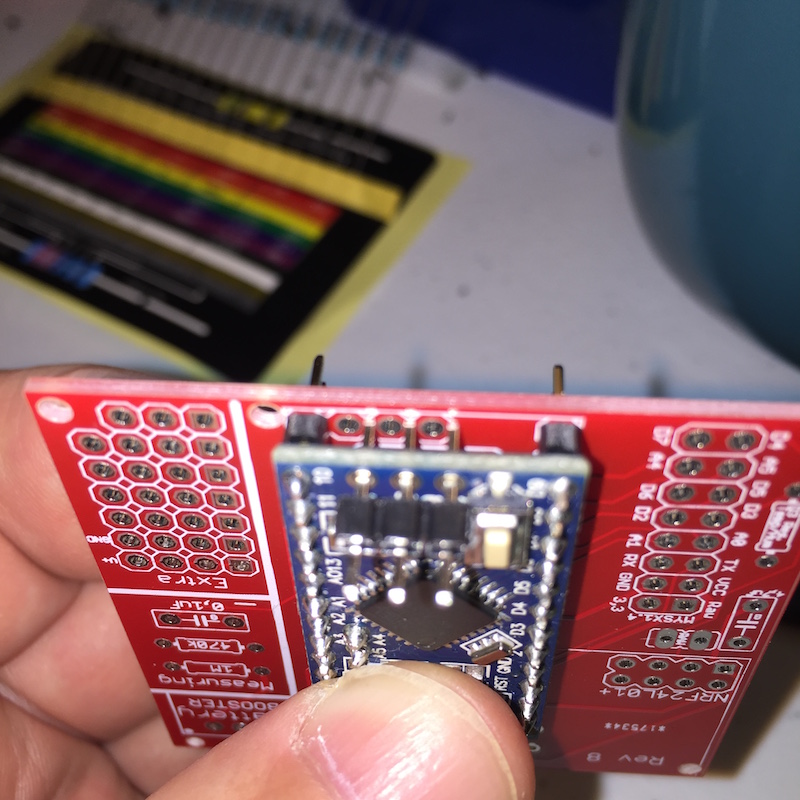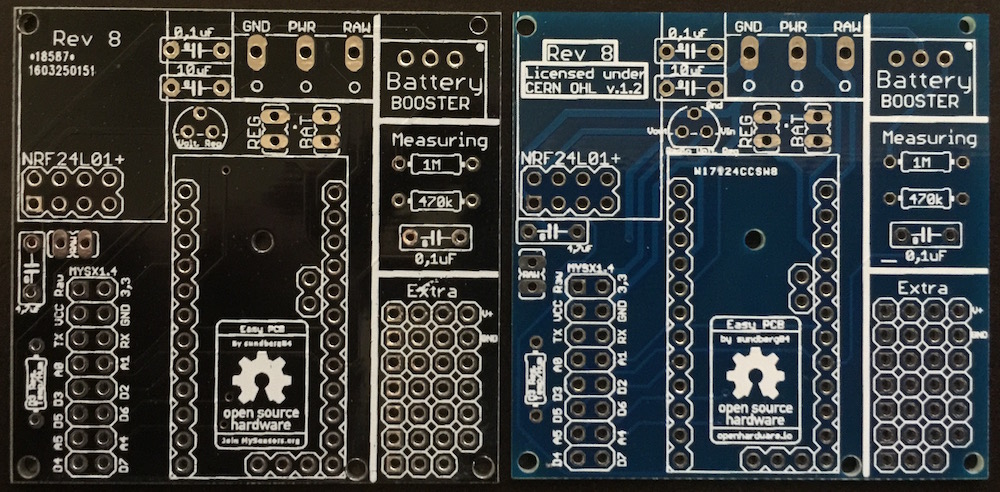Easy/Newbie PCB for MySensors
-
@barduino - thank you for great feedback!
I will look into whats possible if i have any upcoming revs.@sundberg84 , I forgot to mention something.
I get my pro mini's from the local mega store and they have their own brand at a very good price.
In the model they sell the A6, A7 and Ground do not line up with the board.
Not a problem for my applications (I'm thinking of soldering some angled connectors) but I was wondering if they are supposed to be in that position from the original specs.
If you ever think of making the board a bit bigger, having 4 extra connectors for A6, A7, D8 (and an extra ground perhaps) would be nice.
Great job on these!!!
Cheers

-
@barduino nice board. One question, why do you have the cable? Sorry for my newbie question :blush:
-
@nunver, it's not my board, @sundberg84 design it and made it available for all of us.
The wire you see is to connect the RAW input to the voltage divider so I can measure the 9v battery.
Cheers
@barduino yes I know the boards are designed by sundberg84. I got my boards manufactured as well. What I meant was nicely done.
As for the cable, you could have got raw voltage from the battery booster pin. I was wondering if for any specific reason you had the cable. I understand not.
Regarding protection against reverse polarity, can't you use a diode? You loose 0.6V but there is ample margin.
-
@barduino yes I know the boards are designed by sundberg84. I got my boards manufactured as well. What I meant was nicely done.
As for the cable, you could have got raw voltage from the battery booster pin. I was wondering if for any specific reason you had the cable. I understand not.
Regarding protection against reverse polarity, can't you use a diode? You loose 0.6V but there is ample margin.
@nunver your're right I need a more elegant solution for that wire, there was no particular reason to connect it on the other side.
For the protection i'm thinking a daughter board with the diode and the 9v connector and then join it with angle connectors on the main.
Cheers
-
@barduino ok - strange with that footprint.
According to Arduino website those holes does not exist in that position at all (either as your board or my PCB are designed). I downloaded a popular pro mini footprint from somewhere and used that - first time i see they are not aligned. -
yes, indeed

source: https://www.arduino-board.com/boards/arduino-pro-mini
anyway, no worries, I was just curious
Cheers
-
@sundberg84 Assembled my second node. This time 5V regulated. One remark and a quick question. You have LE33 in BOM as regulator. I did not have one readily available but an LM1117 which is a totally different package. I had to go through all datasheets to get correct pinout. Could you put labels near pins like 5 3 G?
And the question; dumb as it may sound, do we place a jumper at REG pins when using the regulator version? :confused:
-
@nunver - great idea with the labels for voltage reg - that makes it more userfriendly! Will do.
Yes - REG should have a jumper connected. -
@shabba - Its a criteria of the MysX connector - to be able to switch RAW on/off from a daughter pcb. Nothing I have ever used and you dont have to think about it until you have a mother/daughter board.
Using RAW input and the internal regulator on the arduino you need to bypass the "REG" jumper and also the external voltage regulator if i remember right.
-
@sundberg84 :+1:
-
@sundberg84
Hey, I've been having a bit of trouble lately.
I've been trying to setup a node with your board which supports a PIR and a temp sensor (ds18b20).
Since there is a spot for a resistor on D3 on your board, I attached the temp sensor to that pin.
The PIR needs a pin that supports interrupts, so I connected that to D2.
Here is where the confusion starts.
If I read this page correctly, D2 is already in use for the radio.
I only checked it after I soldered everything together and found out my PIR doesn't work (it always sends a 1-signal).Any thoughts on this?
Is D2 really free for use on the board?Thanks!
-
@BastienVH - D2 is connected, but at this point not used by the radio (unless its been changed very recently). On the PCB its connected though - so if you want to use this I suggest you do not solder that pin (ie disconnect it) from the PCB and try.
If your PIR doesnt work you should start there... the cheap PIRS are very power sensitive (feed 5v not 3.3!! (you can modify this but standard is 5v!)) so check the connection with a multimeter. Try to connect only PIR and run a basic sketch to get that one to work. As you said you need to connect them to 2 or 3 if you want to use interrupt.
Add some serial.println to get info out whats happeing with the PIR.
-
@BastienVH - D2 is connected, but at this point not used by the radio (unless its been changed very recently). On the PCB its connected though - so if you want to use this I suggest you do not solder that pin (ie disconnect it) from the PCB and try.
If your PIR doesnt work you should start there... the cheap PIRS are very power sensitive (feed 5v not 3.3!! (you can modify this but standard is 5v!)) so check the connection with a multimeter. Try to connect only PIR and run a basic sketch to get that one to work. As you said you need to connect them to 2 or 3 if you want to use interrupt.
Add some serial.println to get info out whats happeing with the PIR.
@sundberg84
About D2: you mean I shouldn't solder the IRQ of the radio to the board?
I will try that next time.I've been testing the PIR with a nano and the 3.3V it supplies and that works fine.
If I take VCC or ground (or both) from the board with booster, the PIR starts acting up.
I guess I'll have to try some more if I want to get to the bottom of things. -
@BastienVH I have tried the normal china-pir (HC-SR501) on 3.3v and it does not work very well. I got random on/off or just strange behaivour. See specs! Voltage is 5V – 20V if you dont modify it (there are some threads on the forum).
The easiest way is to remove the pin for D2 on the arduino pinhead.
-
@sundberg84 Any idea why I've received a "2nd version" of your Rev.8 from PCBWay for free? By free I mean that I bought 10x your Rev.8 about 2 months ago (Black in the photo), but today I've got a package from China and when I opened I got that other PCB that I haven't ordered :confused:
I don't see any changes regarding the radio capacitor. Any clue?
-
@danivalencia - sorry for late reply, I think @hek can help you. Give him a chat about this.
-
@danivalencia - sorry for late reply, I think @hek can help you. Give him a chat about this.
@sundberg84 No worry, I talked with hek and he finded that was a pcbway mistake. BTW...very good job with the PCB, I'm using it with a lot of my sensors :wink:
-
Hi there !
@sundberg84 very nice job ! :)
is there any plan to fit the board for the Arduino Nano (5V) ?
